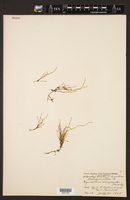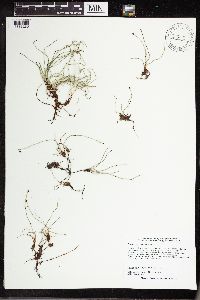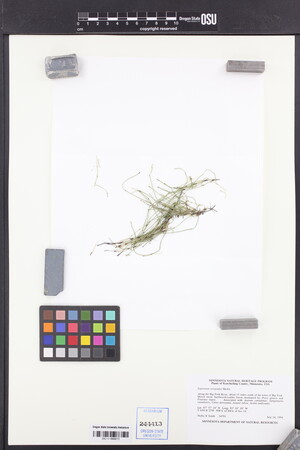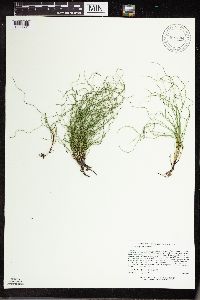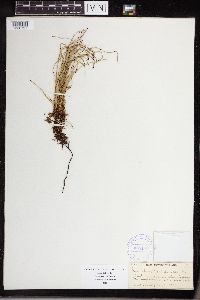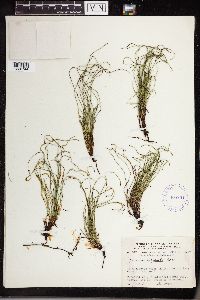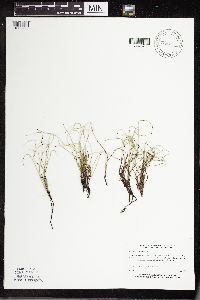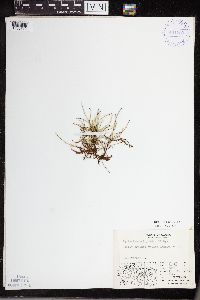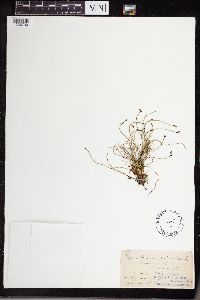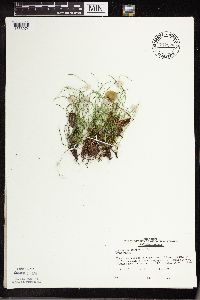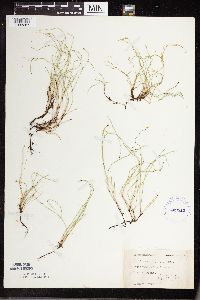Equisetum scirpoides
|
|
|
|
Family: Equisetaceae
Dwarf Scouring-Rush
[Equisetum scirpoides var. minus G. Lawson, moreEquisetum tenellum A. A. Eaton] |
Aerial stems persisting more than a year, unbranched, tortuous, 2.5--28 cm; lines of stomates single; ridges 6. Sheaths green proximally, black distally, elliptic in face view, 1--2.5 × 0.75--1.5 mm; teeth 3, dark with white margins, not articulate to sheath. Cone apex pointed; spores green, spheric. 2 n =216. Cones maturing in summer, or cones overwintering and shedding spores in spring. Wet woods, peat bogs, tundra; 0--1000 m; Greenland; St. Pierre and Miquelon; Alta., B.C., Man., N.B., Nfld., N.W.T., N.S., Ont., P.E.I., Que., Sask., Yukon; Alaska, Idaho, Ill., Iowa, Maine, Mass., Mich., Minn., Mont., N.H., N.Y., S.Dak., Vt., Wash., Wis.; n Eurasia. Perennial herbaceous fern ally 2.5 - 28 cm tall Spores: green, spheric, and released from lengthwise slit in spore sacs (sporangia). Stems: one to several, somewhat sprawling or inclined, contorted, unbranched, grayish green (even during winter), quite small (under 2 mm diameter), rather delicate, round with solid center and six lengthwise rows of grooved, rough ridges with alternating valleys on outside. The stem joints have distinct nodes, and the stomates are sunken and arranged in single lines on each side of the stem valleys. Sheaths: green at base, black near top, 1 - 2.5 mm long, 0.75 - 1.5 mm wide, longer than wide in face view, elongate but somewhat swollen at center. The sheaths are actually small, fused, whorls of leaves. Sheath teeth: three, erect, persistent, with white edges, and dark bases and tips. Similar species: Equisetum scirpoides is quite distinct from the other members of the subgenus Hippochaete because it is much smaller and more delicate, with only three teeth on each stem sheath. It is possible that very small individuals of E. variegatum could be confused with this species, but it will normally have more than three teeth on the stem sheaths, and the teeth are not colored quite the same since they tend to have more dark area and a thinner white margin than in E. scirpoides. There are a few members of the other subgenus that have unbranched fertile stems which may be similar to this species. Fertile stems of E. palustre may appear very similar, but it will normally have more than three teeth per stem sheath, the cone tip is rounded, and the stomates are not sunken but rather scattered or in bands (not in distinct rows or lines). It may be possible to confuse fertile stems of E. fluviatile, but that species will always have more than ten teeth per stem sheath, the sheaths are square in face view, and the cone tip is rounded. Habitat and ecology: Incredibly rare, only reported twice in the two northern most counties of Illinois. Occurence in the Chicago region: native Notes: This plant commonly has the aboveground stems surviving for more than one year. Often the spores survive on the plant over winter and are shed in the spring. This is a more northern species that barely reaches down into the Chicago Region. Author: The Field Museum Stems all alike, evergreen, prostrate or ascending, often bent or contorted, 0.7-2.5 dm, 0.5-1 mm thick, unbranched or with a few long branches, with 3 primary ridges, the ridges tuberculate, broadly and deeply concave, so that the stem appears 6-ridged; central cavity none, vallecular cavities 3, large; stomates in 2 rows in each principal furrow; sheaths 3-4 mm, flaring, with a broad black band above a usually green base, the 3 scarious-margined teeth each with a subulate, often deciduous tip; cones small, 3-5 mm, subsessile, apiculate. Moist, often swampy places, especially in coniferous woods; circumboreal, in Amer. s. to Conn., N.Y., s. Ill., Io., S.D., and Wash. Gleason, Henry A. & Cronquist, Arthur J. 1991. Manual of vascular plants of northeastern United States and adjacent Canada. lxxv + 910 pp. ©The New York Botanical Garden. All rights reserved. Used by permission. |






















